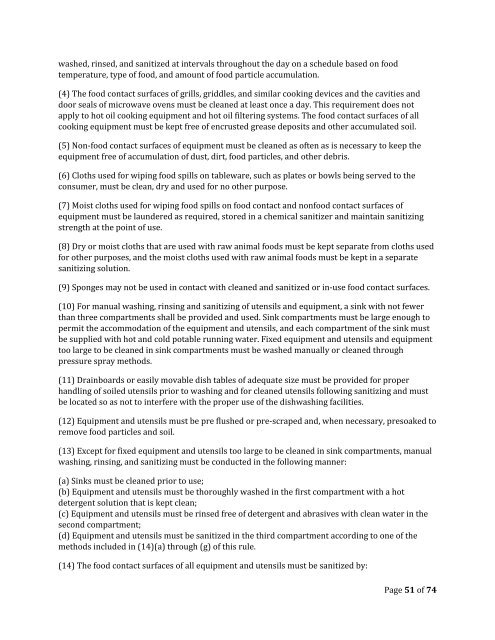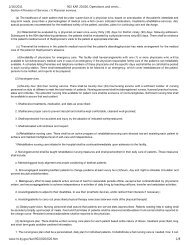State Regulations Pertaining to Dietary Sanitation & Environmental ...
State Regulations Pertaining to Dietary Sanitation & Environmental ...
State Regulations Pertaining to Dietary Sanitation & Environmental ...
Create successful ePaper yourself
Turn your PDF publications into a flip-book with our unique Google optimized e-Paper software.
washed, rinsed, and sanitized at intervals throughout the day on a schedule based on food<br />
temperature, type of food, and amount of food particle accumulation.<br />
(4) The food contact surfaces of grills, griddles, and similar cooking devices and the cavities and<br />
door seals of microwave ovens must be cleaned at least once a day. This requirement does not<br />
apply <strong>to</strong> hot oil cooking equipment and hot oil filtering systems. The food contact surfaces of all<br />
cooking equipment must be kept free of encrusted grease deposits and other accumulated soil.<br />
(5) Non-food contact surfaces of equipment must be cleaned as often as is necessary <strong>to</strong> keep the<br />
equipment free of accumulation of dust, dirt, food particles, and other debris.<br />
(6) Cloths used for wiping food spills on tableware, such as plates or bowls being served <strong>to</strong> the<br />
consumer, must be clean, dry and used for no other purpose.<br />
(7) Moist cloths used for wiping food spills on food contact and nonfood contact surfaces of<br />
equipment must be laundered as required, s<strong>to</strong>red in a chemical sanitizer and maintain sanitizing<br />
strength at the point of use.<br />
(8) Dry or moist cloths that are used with raw animal foods must be kept separate from cloths used<br />
for other purposes, and the moist cloths used with raw animal foods must be kept in a separate<br />
sanitizing solution.<br />
(9) Sponges may not be used in contact with cleaned and sanitized or in-use food contact surfaces.<br />
(10) For manual washing, rinsing and sanitizing of utensils and equipment, a sink with not fewer<br />
than three compartments shall be provided and used. Sink compartments must be large enough <strong>to</strong><br />
permit the accommodation of the equipment and utensils, and each compartment of the sink must<br />
be supplied with hot and cold potable running water. Fixed equipment and utensils and equipment<br />
<strong>to</strong>o large <strong>to</strong> be cleaned in sink compartments must be washed manually or cleaned through<br />
pressure spray methods.<br />
(11) Drainboards or easily movable dish tables of adequate size must be provided for proper<br />
handling of soiled utensils prior <strong>to</strong> washing and for cleaned utensils following sanitizing and must<br />
be located so as not <strong>to</strong> interfere with the proper use of the dishwashing facilities.<br />
(12) Equipment and utensils must be pre flushed or pre-scraped and, when necessary, presoaked <strong>to</strong><br />
remove food particles and soil.<br />
(13) Except for fixed equipment and utensils <strong>to</strong>o large <strong>to</strong> be cleaned in sink compartments, manual<br />
washing, rinsing, and sanitizing must be conducted in the following manner:<br />
(a) Sinks must be cleaned prior <strong>to</strong> use;<br />
(b) Equipment and utensils must be thoroughly washed in the first compartment with a hot<br />
detergent solution that is kept clean;<br />
(c) Equipment and utensils must be rinsed free of detergent and abrasives with clean water in the<br />
second compartment;<br />
(d) Equipment and utensils must be sanitized in the third compartment according <strong>to</strong> one of the<br />
methods included in (14)(a) through (g) of this rule.<br />
(14) The food contact surfaces of all equipment and utensils must be sanitized by:<br />
Page 51 of 74



